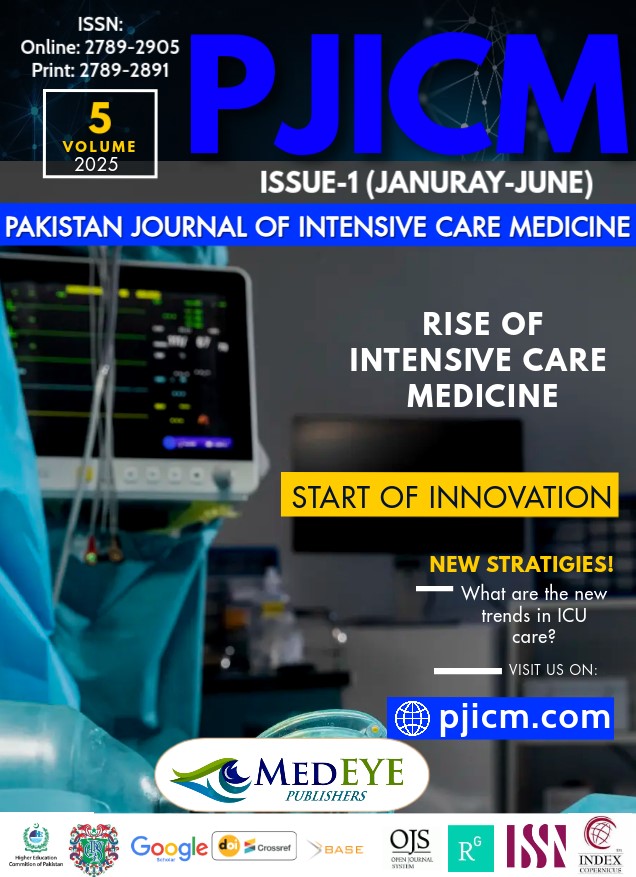PRACTICES AND OUTCOMES OF NEONATAL RESUSCITATION FOR NEWBORNS WITH BIRTH ASPHYXIA IN TERTIARY CARE HOSPITALS IN LAHORE, PAKISTAN
DOI:
https://doi.org/10.54112/pjicm.v5i01.49Keywords:
Neonatal Resuscitation, Birth Asphyxia, APGAR, Healthcare Professional, NewbornAbstract
Background:Neonatal resuscitation (NR) is a critical intervention to reduce neonatal morbidity and mortality associated with birth asphyxia. The effectiveness of NR practices by healthcare professionals (HCPs) significantly influences newborn outcomes. However, gaps in NR training and adherence to standardized resuscitation protocols may impact survival and long-term health. Evaluating NR practices and their association with neonatal outcomes can help identify areas for improvement and optimize neonatal care. Objective: To observe the NR practices of HCPs and their outcomes and to determine the associations between practices and outcomes. Study Design: Observational Cross-sectional study. Setting: The study was conducted in the neonatal resuscitation unit of a tertiary care hospital. Duration of Study: March 2024 to August 2024. Methods: One thousand six hundred and forty neonates were followed, and out of them, a total of 138 newborn resuscitations were observed by 46 HCPs using a predetermined adopted checklist. Newborns with birth asphyxia by the WHO criteria, as well as criteria defined by the American Academy of Pediatrics, were included in the study. The complete bio-data of health care professionals was documented with their way of resuscitation. The observer was present in the resuscitation area every time a delivery was being conducted. Data was analyzed using the SPSS software. The chi-square test was used to determine the association between NR practices and outcomes at one hour. Result: 45.7% of the HCPs were within the age group of 26-30 years, with 55.2% as females. The majority of them are doctors, followed by nurses. 50.7% HCPs prepared the area for resuscitation, and only 18.8% identified a helper. 95.7% dried the baby, and 76.8% removed the wet cloth. 96.4% HCPs cleared the baby's airway. Meconium was present in 42% of neonates. Only 27.9% HCPs started BMV within the Golden minute (60s), 75% used the correct mask size and 96.9% observed chest movement. According to the level of practices by HCPs, good scores were as follows: 74.6% in Drying/Stimulating, 89.7% for Support Ventilation, 39.9% in Open Airway, 27.9 % for BMV, and in ABMW, 44.8% of HCPs demonstrated good practices. 16.7% neonates recovered well, 47.1% needed oxygen therapy, 29% required intensive care, and 7.2% died after 01 hour. Suctioning before the baby breathes (p-value .001), placing the baby's head in a neutral position (p-value = .013), initiation of BMV (p-value <.05), and checking the baby's heart rate after 1 minute (p-value = .022) were associated with newborn outcomes at 1 hour. Conclusion: The Majority of the HCPs were inadequately trained for NR practices. However, a significant association among HCPs' NR practices (airway management and advanced resuscitation practices) and outcomes was observed. Structured and ongoing NR training for HCPs can improve practices and contribute to reduced newborn morbidity and mortality rates. Consequently, it will be helpful for lowering healthcare costs for families and the healthcare system and will contribute to the national economy..
References
Alhassan A, Fuseini AG, Osman W, Basour Adam A. Knowledge and Experience of Neonatal Resuscitation among Midwives in Tamale. Nurs Res Pract 2019; 2019:3652608.
Muganwa K, Muhayimana A, Mukashyaka J, Meharry P. Quality of basic care during neonatal resuscitation at birth among health care providers at three District Hospitals in Kigali City. Rwanda J Med Health Sci 2020; 3(3): 225-37.
Techane MA, Alemu TG, Wubneh CA, Belay GM, Tamir TT, Muhye AB, et al. The effect of gestational age, low birth weight and parity on birth asphyxia among neonates in sub-Saharan Africa: systematic review and meta-analysis: 2021. Ital J Pediatr. 2022 Jul 15;48(1):114.
Ayebare E, Ndeezi G, Hjelmstedt A, Nankunda J, Tumwine JK, Hanson C, et al. Health care workers' experiences of managing foetal distress and birth asphyxia at health facilities in Northern Uganda. Reprod Health 2021;18(1):29.
Becker J, Becker C, Oprescu F, Wu CJ, Moir J, Shimwela M, Gray M. Silent voices of the midwives: factors that influence midwives' achievement of successful neonatal resuscitation in sub-Saharan Africa: a narrative inquiry. BMC Pregnancy Childbirth 2022;22(1):39.
Muhe LM, McClure EM, Nigussie AK, Mekasha A, Worku B, Worku A, et al. Significant causes of death in preterm infants in selected hospitals in Ethiopia (SIP): a prospective, cross-sectional, observational study. Lancet Glob Health 2019;7(8):e1130-38.
Muzzamil M, Nisa M, Raza S. The survival rate of neonates in Pakistan: Problems in health care access, quality and recommendations. Health PromotPerspect 2022;12(4):355-7.
Shikuku DN, Milimo B, Ayebare E, Gisore P, Nalwadda G. Practice and outcomes of neonatal resuscitation for newborns with birth asphyxia at Kakamega County General Hospital, Kenya: a direct observation study. BMC Pediatr 2018;18(1):167.
Johnson PA, Schmölzer GM. Heart rate assessment during neonatal resuscitation. Healthcare (Basel) 2020;8(1):43.
Guta NM. Application of Donabedian quality-of-care framework to assess quality of neonatal resuscitation, its outcome, and associated factors among resuscitated newborns at public hospitals of East Wollega zone, Oromia, Western Ethiopia, 2021. BMC Pediatr 2022;22(1):605.
Ali AEM, EldakhakhnyAM, Mohamed BM, Hanfy MMA. Evaluate Nurses' Practices Regarding Neonatal Resuscitation at Zagazig University Hospitals. Zagazig Nursing J 2023; 19(1): 196-215.
Chaulagain DR, Malqvist M, Brunell O, Wrammert J, Basnet O, Kc A. Performance of health workers on neonatal resuscitation care following scaled-up quality improvement interventions in public hospitals of Nepal - a prospective observational study. BMC Health Serv Res 2021;21(1):362.
Dosoo JK. Determinants of quality neonatal resuscitation among nurses and midwives at the Ga West Hospital.University of Ghana 2022.
United Nations. Transforming our world: the 2030 agenda for sustainable development goals. 2015.
Meena P, Meena M, Gunawat M. Correlation of APGAR score and cord blood pH with severity of birth asphyxia and short-term outcome. Int J ContempPediatr 2017; 4(4): 1325-8.
Bang A, Patel A, Bellad R, Gisore P, Goudar SS, Esamai F, et al. Helping babies breathe (HBB) training: what happens to knowledge and skills over time? BMC Pregnancy Childbirth 2016;16(1):364.
YaregalMelesse D, EnyewAshagrie H. Simulation-based neonatal resuscitation education for undergraduate anesthesia students: a pre- and post-evaluation of knowledge and clinical skills. Anesthesiol Res Pract 2022;2022:7628220.
Ahmed, M. A. 2022. Neonatal Resuscitation: Knowledge and Practices of Nurses and Midwives in Two Hospitals in Mogadishu, Somalia. University of Nairobi.
Wyckoff, M. H., Wyllie, J., Aziz, K., De Almeida, M. F., Fabres, J., Fawke, J., Guinsburg, R., Hosono, S., Isayama, T. & Kapadia, V. S. 2020. Neonatal life support: 2020 international consensus on cardiopulmonary resuscitation and emergency cardiovascular care science with treatment recommendations. Circulation,142(16_suppl_1): S185-S221
Nerdrum Aagaard, E., Solevåg, A. L. & Saugstad, O. D. 2023. Significance of Neonatal Heart Rate in the Delivery Room—A Review. Children,10(9): 1551.
Weiner, G. M. & Zaichkin, J. 2022. Updates for the Neonatal Resuscitation Program and Resuscitation Guidelines. NeoReviews,23(4): e238-e249.
Asadollahi, K., Karimi, A., Rezaei, N., Mussavi, M., Azizi, M. & Daliri, S. 2024. The Apgar Score: A Predictor of Clinical Adverse Outcomes during the Neonatal Period. Journal of Basic Research in Medical Sciences: Volume,11(2).
Dawood, Z. & Majeed, N. 2022. Assessing neo-natal mortality trends in Pakistan: an insight using equity lens. Archives of Public Health,80(1): 7.
Downloads
Published
How to Cite
Issue
Section
License
Copyright (c) 2025 S NASIM , S KOUSAR , W LATIF

This work is licensed under a Creative Commons Attribution-NonCommercial 4.0 International License.












